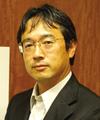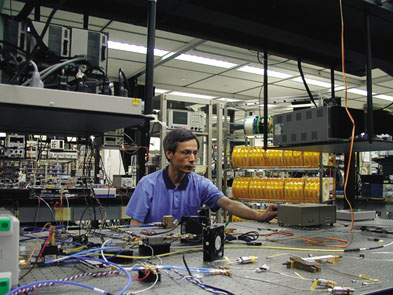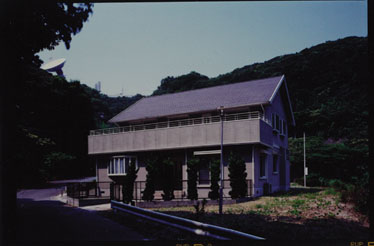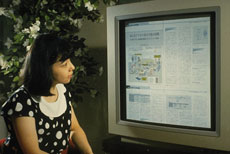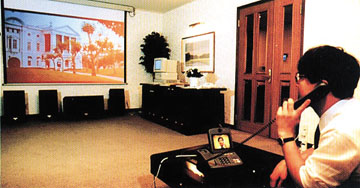Role and mission of
NTT Network Innovation Laboratories
—Mr. Hagimoto, please tell us about the role and mission of the Network Innovation Laboratories.
NTT Network Innovation Laboratories researches and develops technologies centered on three main fields of communications: optical communications, wireless communications, and Internet systems. It was established in 1999 as part of the NTT Science and Core Technology Laboratory Group to consolidate the advanced aspects of each of these different research fields. Since then, it has been researching and developing basic infrastructure technologies for optical and wireless communication systems and advanced subsystem technologies toward the establishment of new service areas.
The mission of Network Innovation Laboratories is twofold. First, it aims to pioneer elemental system technologies and contribute to the development and commercialization of new systems. Second, it aims to turn these advanced elemental technologies into products for NTT Group companies and deploy them within NTT systems to cultivate world-class key technologies.
—What kind of R&D is now being pursued at the Network Innovation Laboratories?
The Network Innovation Laboratories consists of four research sections. The first is the Ubiquitous Service Systems Laboratory that aims to make technological and service-related breakthroughs toward a new era of ubiquitous communications. The second is the Media Innovation Laboratory, which, though basically involved in research on network systems, is also researching networks linked with digital-cinema applications. The third is the Wireless Systems Innovation Laboratory that researches and develops wireless communication systems. And the fourth is the Photonic Transport Network Laboratory that conducts R&D of basic technologies for optical communications infrastructures.
In short, the Network Innovation Laboratories researches and develops advanced, cutting-edge technologies; however, to create definitive systems at NTT, we must use existing technologies with proven performance in combination with new technologies. As part of this process, the Network Innovation Laboratories focuses on R&D of elemental technologies that will constitute that portion of new technologies providing a breakthrough effect. Completing a total system therefore requires that new technologies be skillfully combined with existing technologies and peripheral technologies in a way that is compatible with NTT networks. It is therefore essential that the Network Innovation Laboratories cooperate with the NTT Information Sharing Laboratory Group and NTT Cyber Communications Laboratory Group, and from the viewpoint of cultivating core technologies, collaborate with NTT Group companies and outside enterprises.
—Can you name any research achievements targeted for commercialization?
Yes. One example of recently commercialized technology is an advanced, world-class, large-capacity optical communications system featuring a bit rate of 1.6 Tbit/s per optical fiber achieved by bundling 40 wavelengths each supporting a bit rate of about 40 Gbit/s. This system is being used in NTT Communications' Tokyo-Osaka trunk network and elsewhere. To make the transition from the conventional bit rate of 10 Gbit/s to this new level of 40 Gbit/s, we developed advanced high-speed optical modulation technology and key technology for performing optical-level management within the transmission medium. It was the job of NTT Network Service Systems Laboratories to build a system applicable to business needs on the basis of these technologies and the job of NTT Electronics to supply component technologies for the advanced sections of manufactured equipment.
Importance of improving both accommodation efficiency
and cost performance
—In optical-fiber communications, which is easier to use: a bundle of 40 wavelengths at 40 Gbit/s each or 160 wavelengths at 10 Gbit/s each?
At present, the primary system being used at NTT Communications is an 80-channel version at 10 Gbit/s per channel. The growth in traffic, however, is unbelievably fast. One channel, or a bit rate of 10 Gbit/s, will have to be added every week to keep up with this growth. Increasing the capacity frequently in this way, however, would be inefficient and would increase the size of optical facilities. Combining four channels into one 40-Gbit/s channel makes for smaller facilities and greater capacity. It also responds to the needs of heavy users that use a 40-Gbit/s user interface.
In either case, there is no major difference in ease of use. However, from NTT's point of view, it is essential to be continuously aware of the technical issues related to increasing accommodation efficiency in the face of growing traffic and to correctly forecast network trends.
In other words, there is a need to improve cost performance. If such improvements could not be made, there would be no meaning to developing a 40-Gbit/s channel—using many 10-Gbit/s channels would be fine. Accordingly, when setting out to develop a system with even larger capacity, it is essential that operation know-how be embedded in large-scale integrated circuits (LSIs) and elsewhere to raise accommodation efficiency and cultivate a system that is easy to use.
The problem here is that an investment of funds is needed to support R&D in new areas. And in these times of severe price competition, it is not easy to determine whether that investment can be recovered in a given number of years. The only solution is to establish the merits of developed technology and cultivate it in systems that receive support from the outside world through standardization or de facto standardization.
If we were to become the leader in such a new area and if the technology and products that we developed were to proliferate in the market, we would naturally gain a first-mover advantage. To achieve such a leading position, however, will require much effort, and if, despite this effort, we were then to lose our position in the market, we would not be able to recover our investment. It is for this reason that R&D that acts as a centripetal force to the world is vitally important, and I believe that we have just the technical expertise and environment to do that. We also have the responsibility to carry out R&D that can help raise Japan's international competitiveness.
Constructing a mechanism that connects added value to profits
—Killer content that dominates traffic is not necessarily a killer from the viewpoint of billing.
As in the case of the content and services provided by YouTube and P2P (peer-to-peer) sites, which have recently become popular, there is some traffic for which no money is paid for the added value. Thus, the convenience provided to users by such services generates a problem. At the same time, adopting an attitude like if no money is paid for something, users should not be allowed to use it negates the advantages and attractiveness of broadband connections.
In response to this situation, I believe that the step that we must take is to provide a network like the NGN (next-generation network) that can first expose users to the usefulness and value of particular services, then offer a menu of services through which users can pay for that value, and finally provide services with quality commensurate to that value to people who can appreciate that value.
First, in terms of the infrastructure, we must construct a system that can provide sufficient capacity, and second, on top of this system, we must provide a service menu with high added value on the network side. As to what these services will be, we are now exploring new fields such as 4K digital cinema that I will describe later and value linkage through ubiquitous tags, and we are seeking ways of increasing the added value in the network while conducting trials with leading companies outside NTT.
Addressing the near future at Network Innovation Laboratories
—What efforts are you currently making toward near-future commercialization of technology?
We take the following stance. If the technology that we develop is attractive, professionals in various industries will show interest. Accordingly, whatever it is that attracts them in the first place, it should be a good candidate for commercialization and for making a contribution to society. This is why we provide our technology not just to the NTT Group but to outside companies as well. We actively pursue collaboration with outside enterprises to broaden the range of new services and cultivate business opportunities.
In terms of applications, I'd like to mention an ultrahigh-definition image distribution field trial that is now taking place. This is the “4K Pure Cinema” initiative for delivering ultrahigh-definition motion pictures via high-speed networks. For this trial, a digital-cinema distribution system has been developed using an image platform consisting of 2160 (vertical) × 4096 (horizontal) pixels, four times the number of pixels of conventional high-definition images. Delivery experiments have been in progress for about two years now with the NTT Group and other leading companies including Toho and Warner Brothers. At the Network Innovation Laboratories, we have been developing the technical platform for this system and have been collaborating with the movie industry. We expect this system to be commercialized in the near future [1].
And as another example, there are new ubiquitous services using RFID (radio frequency identification) tags. In this field, the Network Innovation Laboratories first began researching active RFID tags about 7 or 8 years ago. A tag of this type incorporates a battery and may be placed in a card or similar object, and it can emit radio waves on its own. A good analogy is the well-known electronic car key. There are efforts to apply this scheme to a variety of fields. One example is the management of goods, where the use of active RFID tags can achieve traceability when low-power, long-life batteries are attached to goods so that their movement within a limited space can be tracked. Moreover, within a company, such tags can be attached to specific forms to enable the management of their whereabouts. Using such technology, we would like to provide new RFID-based services that use NTT equipment to read data from terminals and sensors.
By incorporating technical know-how that we have accumulated into system LSIs and wireless cards, we plan to expand the possibilities of products and solutions.
References
↑ TOP

